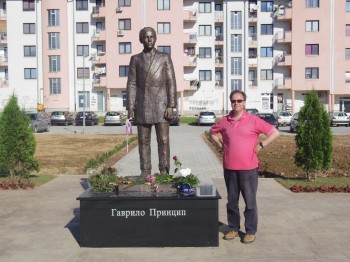As I wrote previously, the city of Sarajevo yesterday commemorated the centenary of the assasination of the Archduke Franz Ferdinand with a fairly confused set of events. A member of a not entirely ceremonial royal family and in a sense therefore a political leader was murdered 100 years ago, as was his wife. Neither of them were bad people and the murder was a horrible thing in itself, even without the terrible events that it set off. The city of Sarajevo held events to commemorate this centenary, but there was much ambiguity about what message (if any) were being sent.
Inevitably, the memories of more recent events in Sarajevo were in the air, even if not explicitly spoken about. The assassin Gavrilo Princip was a Serb nationalist and the sides of buildings in Sarajevo are full of holes that were put there by other Serb nationalists for four years during the siege of Sarajevo between 1992 and 1996.
However, there are two Sarajevos. The bulk of the city is part of the Federation of Bosnia and Herzegovina (not to be confused with the nation of Bosnia and Herzegovina, of which it is a constituent entity), and is populated mostly by Bosnian Muslims, with a small Bosnian Croat population also. However, to the east is Istočno Sarajevo (East Sarajevo), which is part of the Serbian Republic (not to be confused with the Republic of Serbia, of which it is not a constituent entity but would probably like to be) and which is populated by Bosnian Serbs. East Sarajevo consists mostly of new housing that was built on the edge of town using international aid money in order to house Serbs from Sarajevo who either fled or where expelled from Sarajevo during the siege. There is no obvious sign that one is crossing the boundary between the two entities when one does, but they are quite separate just the same. Public transport does not cross the border. People from East Sarajevo to not have access to healthcare in the principal hospital in Sarajevo. People from one side do not socialise or work on the other.
If you look more carefully there are differences between what is on the two sides. As I said, the housing in East Sarajevo is mostly new. The housing in nearby neighbourhoods of non-East Sarajevo are older, and the walls of buildings are full of holes where they were hit by shells during the siege. There is a large and new Orthodox Church overlooking the boundary between the two parts of the city. Away from the populated areas but still on the boundary is the base of the EUFOR peacekeeping force. The boundary goes right through its middle.
Although the memory of the siege of 1992-6 was hanging over the events in the historic part of Sarajevo yesterday, allusions were vague. In East Sarajevo, not so much. Public spaces are still being established in that part of town. One of these is a new park. A ceremony was held yesterday to name it “Gavrilo Princip Park”, and a statue of the murderer himself was also unveiled. Thankfully, I suspect, we did not make it to East Sarajevo for that dedication ceremony. However, we did visit the park and the statue today. A few people were posing for photographs with it. Whereas the main commemorating events were deliberately non-provocative, those in East Sarajevo were extraordinarily provocative, and very crude. Also, insane.





To celebrate the dedication of the statue they should have sacrificed 16% of the population of Serbia. The god of war loves that sort of thing.
No! Really? I am shocked!
those in East Sarajevo were extraordinarily provocative, and very crude. Also, insane.
hi isis
Very interesting article about all this at Shot in the Dark, plus some amazing pictures, esp. the portrait of 9 kings.
In the early years of the 20th century, aristocratic systems which had functioned as political, social, and cultural anchors for hundreds of years collapsed all around the world.
Much of the violence of the remainder of the century was the result of efforts by various hopefuls to inherit the mantle of leadership.
We are still struggling along the fault lines of those fallen empires today, now joined by a few more.
I’m afraid I can foresee the march of lunacy continuing for quite some time if present trends are simply allowed to play out by a supine west.